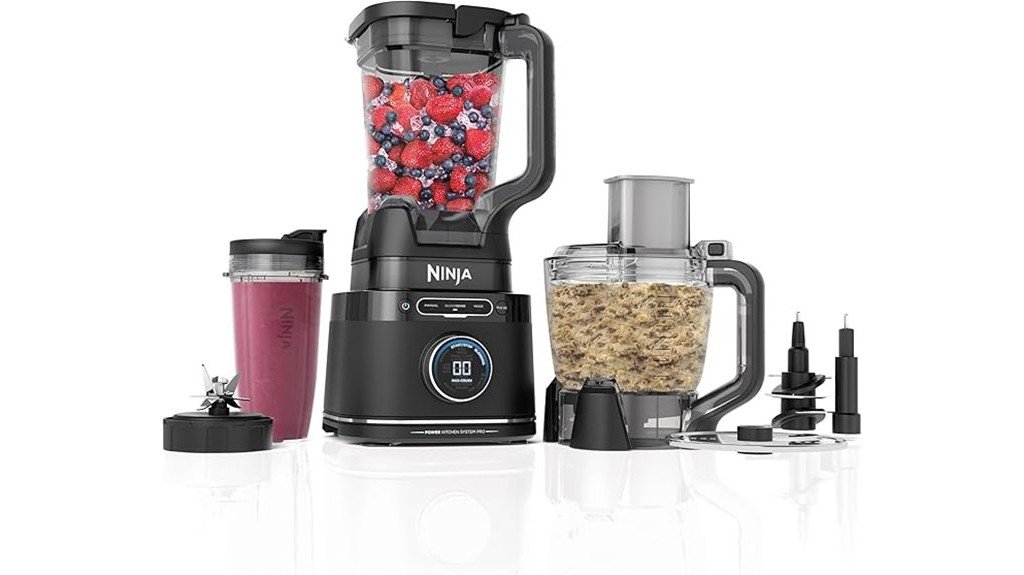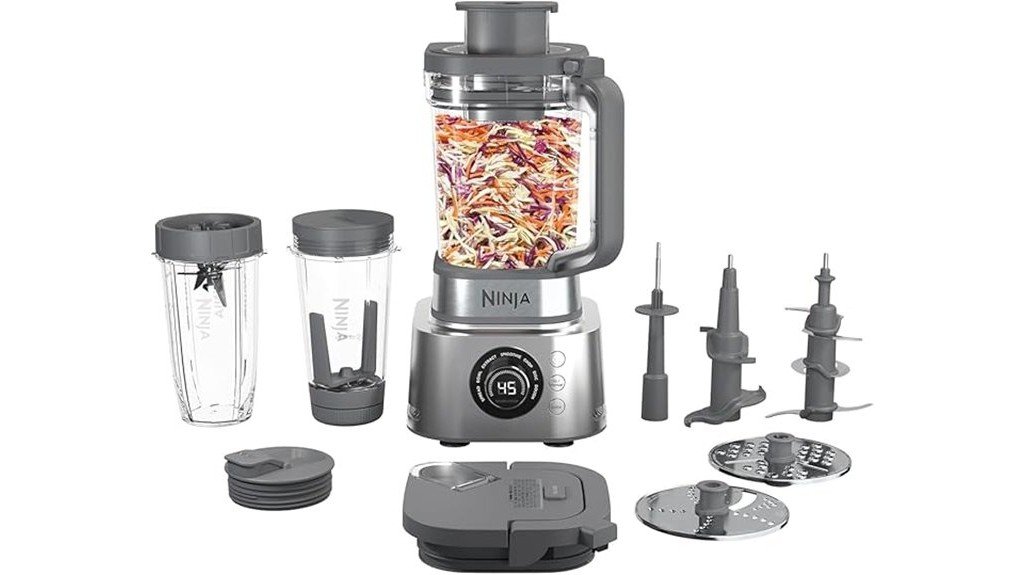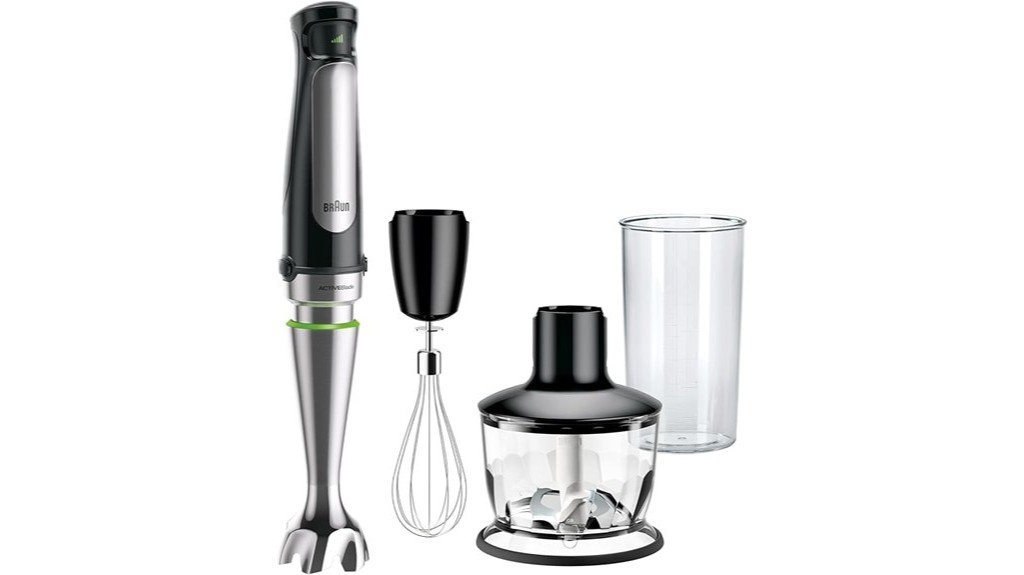We’ve tested dozens of blenders and settled on three that balance power, precision, and easy cleanup for serious food prep. Each brings a different strength—heavy-duty batch processing, smart torque for tough ingredients, or nimble one-handed control—so you can pick the right tool for your kitchen. Keep going and we’ll show what sets each apart and which one fits your routine best.
Ninja All-in-One Blender & Food Processor (TB401)

If you prep meals for a family or like to batch-cook, the Ninja All-in-One Blender & Food Processor (TB401) is built to handle large jobs with its 1800‑watt motor and 72‑oz pitcher, so you’ll get smooth purees and fast dough mixing without slowing down. You’ll use BlendSense tech and 10 variable speeds to let the machine self-adjust or manually fine-tune for smoothies, salsas, dough, and shredding. The 64‑oz food‑processor bowl, 24‑oz single‑serve cup, and multiple blades cover chopping, slicing, shredding, and dough up to 2 lbs. Everything’s top-rack dishwasher safe, and a 1‑year warranty backs the unit.
Best For: Busy cooks and families who need a powerful, versatile blender and food processor for batch cooking, smoothies, dough, and large-prep tasks.
Pros:
- 1800 peak-watt motor and 72 oz pitcher handle large batches and tough ingredients with ease.
- BlendSense technology plus 10 variable speeds offer automatic and manual control for consistent results.
- Comprehensive accessory set (64 oz food‑processor, 24 oz single‑serve, multiple blades/discs) covers chopping, slicing, shredding, and dough up to 2 lbs.
Cons:
- At 14.09 lbs and sizable dimensions, it may be bulky for small kitchens or limited storage space.
- 1-year limited warranty may be shorter than some competitor offerings.
- Liquid Detect feature is limited to the single-serve cup, not available across all attachments.
Ninja Blender & Food Processor Combo (Foodi Power Blender System, SS401)

For home cooks who want a single machine that tackles smoothies, bowls, spreads and food‑processing tasks, the Ninja Foodi Power Blender System (SS401) delivers with a 1600‑peak‑watt motor and smartTORQUE to prevent stalling while handling frozen ingredients and tough nuts. You get a 72‑oz pitcher, XL smoothie bowl maker with tamper, and a 24‑oz Nutrient Extraction Cup plus to‑go cups and discs. Seven Auto‑iQ programs and variable speed control let you dial texture precisely. The enhanced processing lid, Hybrid Edge Blade Assembly and select‑cut discs handle shredding, slicing and grating. Parts are dishwasher safe; reviews rate it 4.7/5.
Best For: home cooks who want an all-in-one blender and food processor that handles smoothies, frozen bowls, nut butters and slicing/shredding tasks with power and convenience.
Pros:
- 1600‑peak‑watt motor with smartTORQUE and 7 Auto‑iQ programs delivers strong, reliable blending and one‑touch presets.
- Includes versatile accessories (72‑oz pitcher, XL smoothie bowl maker with tamper, 24‑oz Nutrient Extraction Cup, to‑go cups, blades and discs) for many kitchen tasks.
- Enhanced processing lid, Hybrid Edge Blade Assembly and dishwasher‑safe parts make shredding/slicing/grating and cleanup easy.
Cons:
- At 12.1 pounds and sizable dimensions, it may be bulky for small kitchens or limited storage.
- High power and multiple components can be louder and more complex to assemble than a basic blender.
- Some users may find specialized discs and attachments unnecessary if they only need simple blending.
Braun MultiQuick 7 3-in-1 Immersion Blender with Food Processor (Handheld Stick Blender)

Home cooks who want a powerful, no-fuss tool for soups, smoothies, and chopping will appreciate the Braun MultiQuick 7’s ACTIVEBlade and 500-watt motor, which give you finer blends and better handling of large or tough ingredients. You’ll like Easy SmartSpeed for one-handed control—press harder to increase speed—and SplashControl keeps your counter cleaner. The PowerBell Plus and flexible ACTIVEBlade shaft boost cutting efficiency, while EasyClick Plus swaps attachments fast: blending wand, whisk, beaker, and a 2-cup chopper. At 2.2 pounds, BPA-free, and highly rated, it’s a versatile, comfortable stick blender for everyday food prep.
Best For: Home cooks who want a powerful, easy-to-use stick blender for soups, smoothies, and chopping tough ingredients with one-handed control.
Pros:
- ACTIVEBlade + 500W motor delivers finer blends and handles large or hard ingredients well.
- Easy SmartSpeed and comfortable grip enable intuitive, one-handed speed control.
- Versatile attachments (blending wand, whisk, beaker, 2-cup chopper) with EasyClick Plus for quick swaps.
Cons:
- 2-cup chopper capacity may be small for larger meal prep tasks.
- Some users may prefer higher wattage for extremely heavy-duty blending.
- Multiple attachments add cleaning and storage considerations.
Factors to Consider When Choosing a Blender for Food
Let’s look at the key factors that help us pick the right blender for food prep: power and motor, blade design, capacity and size, speed controls, and useful processing attachments. We’ll explain how motor wattage and blade shape affect performance and which capacities suit different kitchens. Then we’ll compare speed options and the attachments that expand what a blender can do.
Power and Motor
We should prioritize a blender’s motor power and design because they determine how well it handles tough ingredients and maintains performance under load. We look for wattage ratings—higher watts mean a motor can tackle fibrous vegetables, nut butters, and frozen fruit; an 1800 peak-watt motor, for example, handles a wide variety of foods. Peak watt capability signals maximum output and the motor’s resilience under heavy loads, reducing stall risk. Variable speed control (sometimes up to 10 settings) gives us texture precision, from coarse to silky. Smart torque or similar technologies actively prevent stalling and keep blends consistent, especially with thick mixtures. Combined with efficient motor design, these features guarantee reliable, repeatable performance for serious food prep.
Blade Design
A blender’s blades do the heavy lifting, so we focus on shape, edge count, and materials when choosing a model for food prep. Blade design determines how efficiently ingredients break down and dictates final texture. Multiple-edge, total-crushing blades handle ice and frozen fruit better, giving consistently smooth results. Hybrid-edge blades blend chopping and pureeing tasks, so we can make chunky salsas and silky smoothies with the same unit. Some systems add a milling blade to slice and puree larger pieces faster, cutting prep time. Material and edge retention matter: stainless steel resists corrosion and keeps sharpness longer, maintaining performance. When evaluating blenders, we prioritize versatile geometries and durable, sharp materials for reliable, predictable food prep.
Capacity and Size
Size matters when we’re picking a blender for food prep: choose a pitcher or bowl capacity that matches the batches you’ll make—72 oz. or 64 oz. sizes work for soups and large smoothies, while smaller jars and single-serve cups handle individual portions and quick tasks. We also check overall dimensions so the unit fits on our counter or tucks into a cabinet without awkward maneuvering. Weight matters too: heavier bases often stay steadier when we process dense or fibrous ingredients. We favor systems offering multiple containers—small chopper bowls, personal cups, and large pitchers—so we can switch tasks without extra appliances. Finally, we evaluate specific processing capacity for jobs like dough or nut butters to guarantee the blender meets our recipe demands.
Speed Controls
Because texture makes or breaks many recipes, we want speed controls that give us precise, repeatable results. Variable speed settings let us dial in the right shear and pause to check consistency; models with up to ten speeds are particularly useful when switching between delicate sauces and hearty purees. Automatic speed adjustment is a big plus — blenders that sense load and adapt cut down on trial-and-error and maintain texture. Preset programs offer one-touch convenience for common tasks like smoothies or nut purees, saving time while delivering consistent outcomes. For thick mixes and frozen fruit, having a tamper plus responsive lower-speed control helps prevent air pockets and guarantees smoothness. In short, choose controls that match your recipes and cooking rhythm.
Processing Attachments
When we choose a blender for serious food prep, we should examine the processing attachments it comes with, since bowls, choppers, and slicing/shredding discs determine how many tasks the machine can handle. We’ll prioritize models that include a range of attachments—a large food-processor bowl for batches, a smaller 24 oz. cup for single servings, and dedicated slicing/shredding discs—so we can move from chopping to grating without extra appliances. Look for specialized blades, like hybrid edge or total crushing blades, to tackle frozen fruit, nuts, and ice reliably. A useful feed chute with a pusher lets us add ingredients mid-process without stopping. Finally, confirm attachment capacity matches your meal prep needs and that components are dishwasher-safe for straightforward cleanup.
Cleaning and Maintenance
While we’re picking a blender for heavy food prep, we should prioritize models that make cleanup simple and reliable. We recommend dishwasher-safe containers, lids, and blades so routine cleaning is quick and hands-off. Removable blades are a must; they let us access crevices and remove trapped food without risking cuts. A splash-minimizing design also matters—less mess during operation means less post-use scrubbing. We prefer BPA-free materials that wipe down easily and resist staining or odors, keeping hygiene straightforward. Finally, we always read user feedback on cleaning ease: real-world ratings often reveal whether a model lives up to its “easy clean” claims and highlight any recurring maintenance hassles before we buy.
Warranty and Support
Cleaning ease matters, but that’s only part of the ownership story; we also need to contemplate warranty and support. We look for clear warranty lengths—some models have only a one-year limited warranty, while others provide fuller terms upon request—and factor that into value. We check customer support hours and responsiveness because slow service turns small issues into big headaches. We read reviews to gauge whether manufacturers honor claims and supply replacement parts reliably. Brands with robust support and accessible user manuals, troubleshooting guides, and recipe resources make the learning curve smoother and extend product life. Before buying, we recommend confirming warranty details, noting how to contact support, and scanning user feedback to avoid surprises after purchase.
Conclusion
We’ve picked three standouts that make food prep faster and cleaner: the Ninja TB401 for raw power and big batches, the Ninja SS401 for smart torque and tough jobs, and the Braun MultiQuick 7 for nimble, one-handed control. Whatever you choose, you’ll get dishwasher-safe parts and reliable performance—small tools, big impact—so your kitchen work stays efficient, precise, and easy to maintain, meal after meal.

